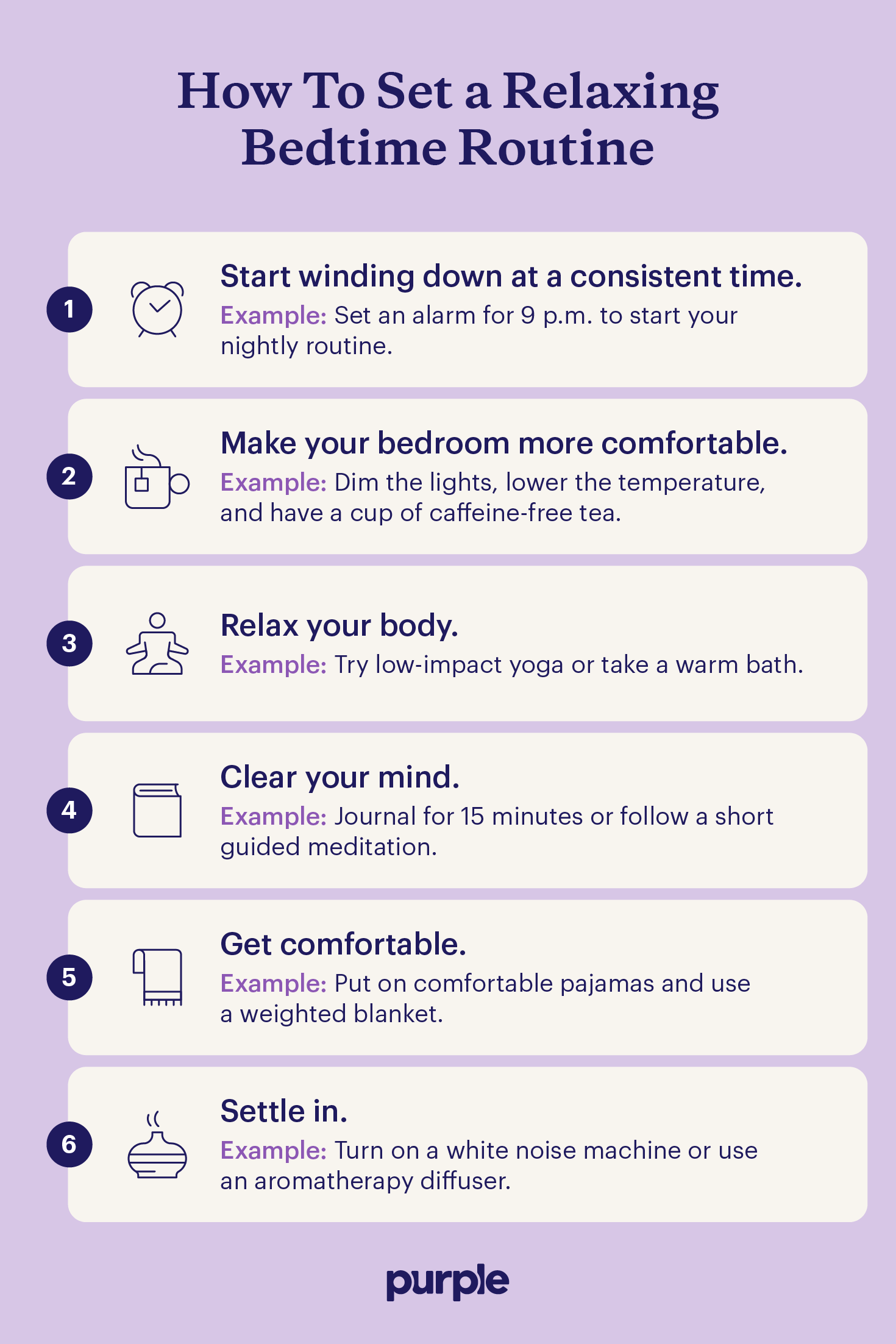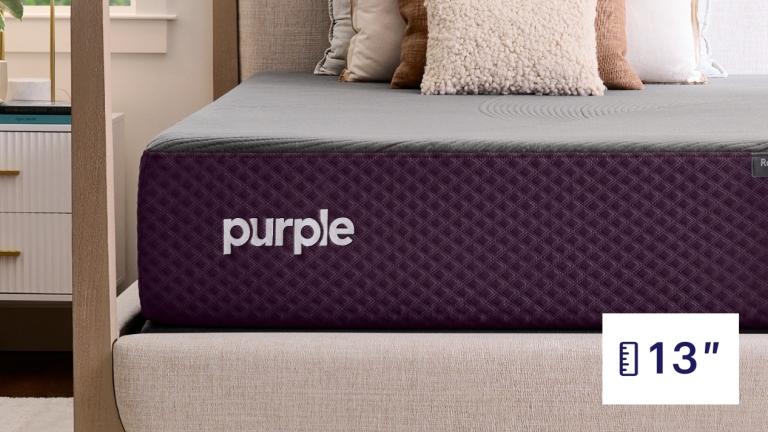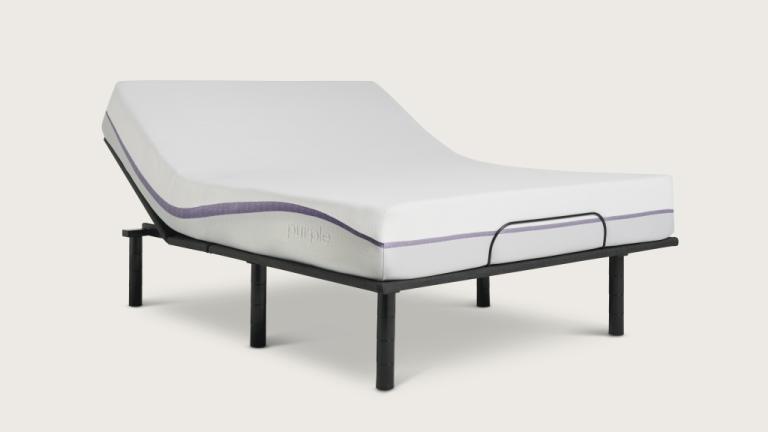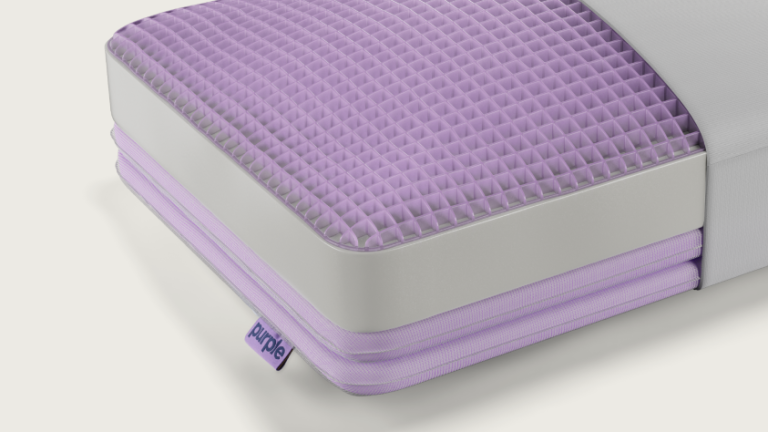
Bedtime Routines for Adults: How to Reset Circadian Rhythm + 13 Tips
Key Takeaways
- Sticking to the same bedtime routine every night regulates your internal clock and helps you fall asleep faster.
- Improve sleep hygiene by replacing late-night screentime with aromatherapy, guided meditation, sleep yoga, and more.
- Create the perfect bedtime routine by incorporating your favorite tips and habits from below.
After you brush your teeth, what does the rest of your night look like? Do racing thoughts keep you awake, or do you get stuck scrolling through social media feeds?
If this sounds familiar, you’re not alone.
An estimated 50 to 70 million Americans struggle with ongoing sleep problems. In fact, about one-third of adults in the United States report not getting enough sleep at night.1
Turns out a cozy bedtime routine isn't just for kids. Maintaining a consistent nighttime routine helps you maintain good sleep hygiene, stay asleep all night, and feel more functional throughout your day. Keep reading to explore twelve helpful tips that make up healthy bedtime routines for adults.
1. Set an Alarm
No, we don’t mean your morning alarm (although that’s important, too!).
Set an alarm to remind you to start getting ready for bed each night. This helps you stay consistent and know when to wind down. Pick a bedtime and try your best to stick to it, even on weekends, in order to regulate your body’s internal clock.
2. Avoid Eating and Drinking
Since the process of digestion keeps you awake, you should stop eating at least three hours before bed.2 Similarly, stop drinking at least two hours before bed to prevent trips to the bathroom in the middle of the night.
Avoid stimulants like caffeine for at least six hours before bedtime. In addition, drinking alcohol disrupts your circadian rhythm. Research indicates that consuming a moderate dose of alcohol up to an hour before sleeping could significantly reduce melatonin production.3
3. Keep It Cool
Your body’s core temperature naturally drops at night, so keeping the thermostat low encourages the onset of sleep. Aim for a setting of 66°F to 70°F, though the best temperature for sleep will vary depending on your age group. When it comes to bedding materials, hot sleepers may benefit from cooling sheets.
4. Dim the Lights
Yes, this one’s obvious, but darkness is important for sleep quality. Invest in some blackout curtains and start dimming the lighting in your home hours before bedtime.
Stick with lamps, not overhead lights. While you should never fall asleep with lit candles, you can mimic cozy candlelight with a flickering nightlight or a flameless candle lamp on an end table.
The color of your lighting matters, too: red light therapy has been shown to positively affect sleep quality, while blue light sources will keep you up.
5. Put a Stop to Screentime
Since blue light at night is detrimental to your sleep, you should avoid all electronic device screens for at least one hour before bed.
Need some relaxing analog alternatives to scrolling social media? Try these:
- Puzzles
- Knitting/crocheting
- Adult coloring books
6. Plan Your Next Morning
Staying organized and preparing for the day ahead can help put your mind at ease. Decrease anxiety and morning jitters by picking out an outfit, packing a lunch for work, or writing a to-do list for the next day.
7. Read a Book or Write in a Journal
Reading a physical book is a great way to wind down at night while avoiding digital screens. Alternatively, you can write in a journal.
Journaling doesn’t have to take long in your nightly routine; you can keep a gratitude journal with a few short bullet points of things that made you smile that day. “Brain dumping,” or jotting down a freeform stream of consciousness onto a page, can also help you let go of any anxieties that may be keeping you up at night.
8. Listen to a Calming Playlist or Guided Meditation
Build a bedtime playlist based on your own personal tastes. Explore brown noise, white noise, pink noise, rainfall, calming ambient music, classical music, and more. Avoid upbeat music or songs with lyrics, as they may distract you.
For a more structured experience, check out guided meditation videos and podcasts or follow along with instructions for deep breathing exercises for sleep. These can help slow your heart rate, calm your nervous system, and prepare your body for sleep.
9. Try Yoga for Sleep
Some people make the mistake of exercising too close to bedtime, trying to tire themselves out. Completing a strenuous workout actually raises your heart rate and body temperature, making it harder to fall asleep. However, light stretches and specially engineered sleep yoga can help.4 Try following a gentle sleep yoga routine about 90 minutes before bed.
10. Have a Cup of Tea
Nothing beats curling up with a warm cup of tea. Herbal teas like chamomile, lavender, valerian root, passionflower, and lemon balm are all great for sleep. Just make sure your tea of choice is free of caffeine!
11. Take a Warm Bath or Shower
Taking a warm bath or shower one to two hours before bed can improve sleep quality by easing muscle tension, reducing stress, and regulating your core temperature. Adding elements like Epsom salts or calming essential oils can further enhance the soothing effects of a bath or shower.
How does it work? When you’re in warm water, your body temperature temporarily rises. When you get out, water evaporates from your skin, creating a rapid cooling effect that helps lower your core body temperature and signal that it’s time for rest.
12. Indulge in Aromatherapy
The smells of lavender, cedarwood, bergamot, and chamomile essential oils are known to promote relaxation. While you may want to invest in a diffuser for aromatherapy, topical application works just as well. As a part of your night routine, lightly apply the essential oil on the wrists, temples, soles of the feet, and behind the ears. You can also put a few drops on your pillowcase or add them to your bath.
13: Keep Your Bed Dedicated To Sleep
Your bed should be dedicated to sleeping. Avoid using your laptop, watching TV, or snacking in bed. Setting this boundary helps signal to your body and mind that the bedroom is a sanctuary for rest. While this can be tough to enforce in small spaces like studio apartments, this rule will improve sleep hygiene. Make your bed extra inviting with premium pillows and an adjustable base!
6 Benefits of a Bedtime Routine
Establishing a bedtime routine doesn’t just help you sleep better. It improves nearly every aspect of your health and well-being. By dedicating time to wind down and prioritize rest, you’re investing in a healthier, happier, and more productive life.
Here’s how sticking to a nightly schedule positively impacts several key areas of your life.
Metabolism
Good sleep helps with weight management by regulating hunger hormones like leptin and ghrelin, while studies have linked sleep deprivation to weight gain.5
Energy Levels
Getting enough sleep gives you more energy and alertness during the day, reducing dependence on caffeine and other stimulants.
Immune System
Research shows that people who sleep fewer than 6 hours per night are much more likely to catch a cold than those who sleep six or more hours.6 Sleep plays a critical role in immune function, as it allows your body to produce cytokines that fight infection and inflammation.
Cardiovascular Health
Deep sleep stages help regulate stress hormones, keeping blood pressure in check and reducing strain on the heart. On the other hand, sleep deficiency has been linked to high blood pressure and heart disease.
Mood and Mental Health
Restorative sleep allows the brain to process emotions, reducing the risk of depression, anxiety, and mood instability. Quality sleep also boosts serotonin levels, improving emotional regulation and reducing irritability. Conversely, poor sleep increases the risk of anxiety and depression.
Memory and Concentration
Sleep is essential for memory consolidation, where the brain processes and stores information from the day. Studies show that sleep-deprived individuals perform worse on memory-related tasks when compared to well-rested people. 7, 8
Get Better Sleep With a Tailored Bedtime Routine and a Purple Mattress
The perfect bedtime routine for adults will be different for each person, so mix and match the tips above to find what works best for you. Start small with one or two changes, then work your way up. Establishing a new routine takes time, but improved sleep quality is worth the effort.
One thing’s for sure: an uncomfortable bed can disrupt your sleep, no matter what routine you try. If it's time for a mattress upgrade, explore pressure-relieving Purple mattresses with our patented GelFlex Grid® technology.
FAQ
People tend to associate bedtime routines with children, but a bedtime routine is also essential for adults. It helps signal to the brain and body that it's time to wind down, creating a smoother transition from wakefulness to sleep. Keeping a consistent routine regulates your internal clock (also known as your circadian rhythm), making it easier to fall asleep and wake up at the same time each day.9 Over time, this improves sleep quality and reduces the risk of insomnia.
Additionally, relaxing bedtime routines reduce stress and anxiety. Engaging in calming activities like journaling, meditation, or light stretching before bed can lower cortisol levels.
The ideal bedtime will vary depending on factors like your age, lifestyle, and activity level, but scientists recommend seven to nine hours of sleep per night for adults.10 To maintain a consistent circadian rhythm, go to bed and wake up at the same times every day.
Let’s break it down further:
- The average sleep cycle is 90 minutes.
- A good night of sleep includes 5 full sleep cycles.
- 5 x 90 minutes = 450 minutes.
- 450 minutes / 60 minutes = 7.5 hours.
Check out our handy sleep calculator for more details.
As your evenings come to a close, the 3-2-1 bedtime rule sets some simple guidelines for better sleep:
- 3 hours before bed: Stop eating to allow your body to digest food fully. This also helps prevent acid reflux.
- 2 hours before bed: Avoid drinking large amounts of liquid to avoid running to the bathroom in the middle of the night.
- 1 hour before bed: Turn off all devices and screens to limit your exposure to blue light, as it can suppress melatonin production and keep you awake.
The 5-4-3-2-1 technique is a popular mindfulness exercise designed to help you feel more grounded and relaxed. It can also reduce stress before bed. To try it out, engage each of your five senses:
- Name five things you can see: Look around and name five items in your environment.
- Name four things you can touch: Focus on textures or objects at your fingertips, like your blanket or pillow.
- Name three things you can hear: Listen to ambient sounds, like a fan or relaxing music.
- Name two things you can smell: Inhale calming scents, such as lavender or chamomile.
- Name one thing you can taste: Savor a sip of herbal tea.
Late nights and special occasions are bound to happen, even if you try to stick to a strict bedtime. The 80/20 rule, also known as the Pareto principle, accounts for this. It promotes maintaining a consistent sleep routine roughly 80% of the time while allowing for flexibility in your schedule for the remaining 20%.
More To Explore
Level up your sleep routine with our most-loved products.







